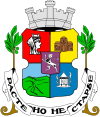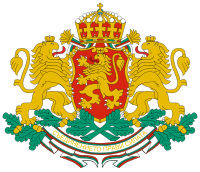Sofia
| Sofia София |
|||
|---|---|---|---|
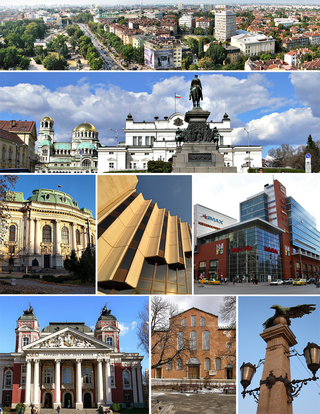 |
|||
|
|||
| Motto: Расте, но не старее (It Grows but Does not Age)[1] |
|||
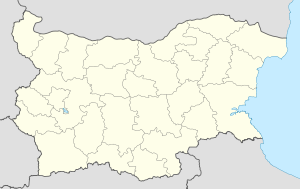 Sofia
|
|||
| Coordinates: | |||
| Country | Bulgaria | ||
| Province | Sofia-City | ||
| Settled by Celts | as Serdica 4th century BC | ||
| Government | |||
| - Mayor of Sofia | Yordanka Fandakova | ||
| Area | |||
| - City | 492 km2 (190 sq mi) | ||
| Elevation | 550 m (1,804 ft) | ||
| Population (15.07.2010) | |||
| - City | |||
| - Density | 2,857/km2 (7,399.6/sq mi) | ||
| - Metro | |||
| Time zone | EET (UTC+2) | ||
| - Summer (DST) | EEST (UTC+3) | ||
| Postal code | 1000 | ||
| Area code(s) | (+359) 02 | ||
| Website | sofia.bg | ||
Sofia (Bulgarian: София, pronounced [ˈsɔfija] (![]() listen)) is the capital and largest city[2] of Bulgaria and the 47th largest city by population in the European Union, with 1.4 million people living in the Capital Municipality.[3] It is located in western Bulgaria, at the foot of Mount Vitosha, and is the administrative, cultural, economic, and educational centre of the country.
listen)) is the capital and largest city[2] of Bulgaria and the 47th largest city by population in the European Union, with 1.4 million people living in the Capital Municipality.[3] It is located in western Bulgaria, at the foot of Mount Vitosha, and is the administrative, cultural, economic, and educational centre of the country.
Prehistoric settlements were excavated in the centre of the present city, near the royal palace, as well as in outer districts such as Slatina and Obelya. The well-preserved town walls (especially their substructures) from antiquity date back before the 7th century BC, when Thracians established their city next to the most important and highly respected mineral spring, still functioning today. Sofia has had several names in the different periods of its existence, and remnants from the city's past can still be seen today alongside modern landmarks.
Names
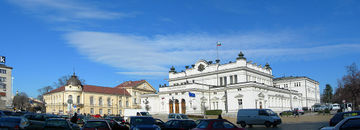
Sofia was first mentioned in the sources as Serdica in relation to Marcus Licinius Crassus' campaigns in 59 BC. The name Serdica or Sardica (Σερδική, Σαρδική) was popular in Latin, Ancient Greek and Byzantine Greek sources from Antiquity and the Middle Ages; it was related to the local Celtic[4] tribe of the Serdi. The name was last used in the 19th century in a Bulgarian text, Service and hagiography of Saint George the New of Sofia: ВЪ САРДАКІИ. Another of Sofia's names, Triaditsa (Τριάδιτζα), was mentioned in Greek medieval sources. The Bulgarian name Sredets (СРѢДЄЦЪ), which is related to среда sreda (middle), first appeared in the 11th-century Vision of Daniel and was widely used in the Middle Ages. The current name Sofia was first used in the 14th-century Vitosha Charter of Bulgarian tsar Ivan Shishman or in a Ragusan merchant's notes of 1376; it refers to the famous Hagia Sophia Church, an ancient church in the city named after the Christian concept of the Holy Wisdom. Although Sredets remained in use until the late 18th century, Sofia gradually overcame the Slavic name in popularity.[5] During the Ottoman rule it was called Sofya by the Turkish population.
The city's name is pronounced by Bulgarians with a stress on the 'o', in contrast with the tendency of foreigners to place the stress on 'i'. Interestingly, the female given name "Sofia" is pronounced by Bulgarians with a stress on the 'i'.
Geography
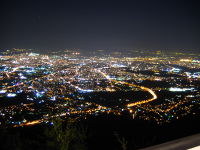
.jpg)
Sofia's development as a significant settlement owes much to its central position in the Balkans. It is situated in western Bulgaria, at the northern foot of the Vitosha mountain, in the Sofia Valley that is surrounded by mountains on all sides. The valley is the largest one in the country with territory of 1,186 square kilometres (458 sq mi) and average altitude of 550 metres (1,800 ft). Three mountain passes lead to the city, which have been key roads since antiquity, connecting the Adriatic Sea and Central Europe with the Black and Aegean Seas. A number of low rivers cross the city, including the Vladaiska and the Perlovska. The Iskar River in its upper course flows near eastern Sofia. The city is known for its numerous mineral and thermal springs. Artificial and dam lakes were built in the last century.
It is located 130 kilometres (81 mi) northwest of Plovdiv,[6] Bulgaria's second largest city, 340 kilometres (211 mi) west of Burgas[6] and 380 kilometres (240 mi) west of Varna,[6] Bulgaria's major port-cities on the Bulgarian Black Sea Coast. The city is situated at less than 200 kilometres (120 mi) from the borders with three countries: 55 kilometres (34 mi) from Kalotina on the Serbian border, 113 kilometres (70 mi) from Gyueshevo on the frontier with the Republic of Macedonia and 183 kilometres (114 mi) from the Greek border at Kulata.
Climate
Sofia has an oceanic climate (Koppen Cfb)[7] near the boundary of the humid continental climate with high temperature amplitudes. The hottest month is July while January is the coldest. Up to 1936 the average annual temperature was 10.0 °C (50.0 °F) and since then it has risen by 0.5 °C (0.9 °F).[8] The city receives around 650 millimetres (26 in) annual precipitation with summer maximum and winter minimum. The temperatures in Sofia generally remain cooler than other parts of Bulgaria in summer, due to the high altitude of the valley in which it is situated.
| Climate data for Sofia | |||||||||||||
|---|---|---|---|---|---|---|---|---|---|---|---|---|---|
| Month | Jan | Feb | Mar | Apr | May | Jun | Jul | Aug | Sep | Oct | Nov | Dec | Year |
| Average high °C (°F) | 2.2 (36) |
5.0 (41) |
9.8 (49.6) |
15.3 (59.5) |
20.1 (68.2) |
23.5 (74.3) |
25.9 (78.6) |
25.7 (78.3) |
22.6 (72.7) |
16.6 (61.9) |
9.6 (49.3) |
4.0 (39.2) |
15.0 (59) |
| Average low °C (°F) | -4.9 (23.2) |
-2.9 (26.8) |
0.3 (32.5) |
4.7 (40.5) |
9.4 (48.9) |
12.4 (54.3) |
13.8 (56.8) |
14.3 (57.7) |
10.6 (51.1) |
5.7 (42.3) |
1.3 (34.3) |
-2.7 (27.1) |
5.2 (41.4) |
| Rainfall mm (inches) | 31 (1.22) |
34 (1.34) |
37 (1.46) |
49 (1.93) |
78 (3.07) |
75 (2.95) |
56 (2.2) |
49 (1.93) |
38 (1.5) |
35 (1.38) |
53 (2.09) |
44 (1.73) |
579 (22.8) |
| Avg. rainy days | 7 | 5 | 8 | 9 | 6 | 4 | 2 | 2 | 4 | 7 | 9 | 6 | 69 |
| Sunshine hours | 74.4 | 98.9 | 136.4 | 171.0 | 210.8 | 243.0 | 285.2 | 272.8 | 216.0 | 170.5 | 96.0 | 65.1 | 2,040.1 |
| Source: Hong Kong Observatory 1961-1990 [9] | |||||||||||||
History
Antiquity
Sofia was originally a Thracian settlement called Serdica, or Sardica, possibly named after the Celtic tribe Serdi.[4] For a short period during the 4th century BC, the city was ruled by Philip of Macedon and his son Alexander the Great.
Around BC 29, Serdica was conquered by the Romans. It became a municipium, or centre of an administrative region, during the reign of Emperor Trajan (98-117) and was renamed Ulpia Serdica.
It seems that the first written mention of Serdica was made by Ptolemy (around 100 AD). Serdica (Sardica) expanded, as turrets, protective walls, public baths, administrative and cult buildings, a civic basilica, an amphitheatre - the City Council (Boulé), a large Forum, a big Circus (Theatre), etc. were built.
When Emperor Diocletian divided the province of Dacia into Dacia Ripensis (at the banks of the Danube) and Dacia Mediterranea, Serdica became the capital of Dacia Mediterranea. The city subsequently expanded for a century and a half, it became a significant political and economical centre, moreso — it became one of the first Roman cities where Christianity was recognized as a official religion (Еmperor Galerius). So it was only very natural that Constantine the Great called Serdica (Sardica) "My Rome". In 343 AD, the Council of Sardica was held in the city, in a church located where the current 6th century Church of Saint Sofia was later built. Serdica was of moderate size, but magnificent as an urban concept of planning and architecture, with abundant amusements and an active social life. It flourished during the reign of Byzantine Emperor Justinian I, when it was surrounded with great fortress walls whose remnants can still be seen today.
The city was destroyed by the Huns in 447 but was rebuilt by Justinian and for a while called Triaditsa or Sredets by the slavonic tribes.
Middle Ages
Sofia first became part of the First Bulgarian Empire during the reign of Khan Krum in 809, after a long siege.[10] Afterwards, it was known by the Bulgarian name "Sredets" and grew into an important fortress and administrative centre. After the fall of North-eastern Bulgaria under John I Tzimiskes' armies in 971, the Bulgarian Patriarch Damyan chose Sofia for his seat in the next year. After a number of unsuccessful sieges, the city fell to the Byzantine Empire in 1018, but once again was incorporated into the restored Bulgarian Empire at the time of Tsar Ivan Asen I.
From the 12th to the 14th century, Sofia was a thriving centre of trade and crafts. It is possible that it had been called by the common population Sofia (meaning "wisdom" in Ancient Greek) about 1376 after the Church of St. Sofia. However, in different testimonies it was called both "Sofia" and "Sredets" until the end of the 19th century. In 1382, Sofia (Turkish: Sofya) was seized by the Ottoman Empire in the course of the Bulgarian-Ottoman Wars - after a long siege the city was captured with treason. The new name "Sofia" replaced the old one ("Sredets"), after the liberation of the city from Turkish rule in 1878. Quite some time after 1878 there was a strong will, expressed by Bulgarian committees, to keep the name Sredets, but the Russian administration accepted Sofia.
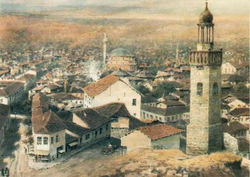
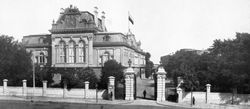
Ottoman rule
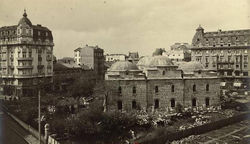
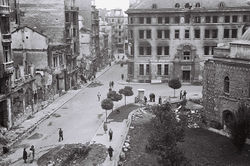
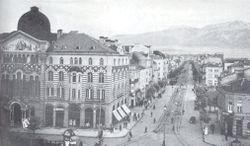
After the campaign of Władysław III of Poland in 1443 towards Sofia, the city's Christian elite was annihilated and became the capital of the Ottoman province (beylerbeylik) of Rumelia for more than 4 centuries, which encouraged many Turks to settle there. In the 16th century, Sofia's urban layout and appearance began to exhibit a clear Ottoman style, with many mosques, fountains and hamams (bathhouses). During that time the town had a population of around 7,000.
The town was seized for several weeks by Bulgarian haiduks in 1599. In 1610 the Vatican established the See of Sofia for Catholics of Rumelia, which existed until 1715 when most Catholics had emigrated.[11] In the 16th century there were 126 Jewish households, and there has been a synagogue in Sofia since 967. She was the center of Sofya Eyalet (1826–1864).
End of Ottoman Rule
Sofia was taken by Russian forces on January 4, 1878, during the Russo-Turkish War, 1877-78, and became the capital of the autonomous Principality of Bulgaria in 1879, which became the Kingdom of Bulgaria in 1908. It was proposed as a capital by Marin Drinov and was accepted as such on 3 April 1879. By the time of its liberation the population of the city was 11,649.[12] For a few decades after the liberation the city experienced large population growth mainly from other regions of the country.
During World War II, Sofia was bombed by Allied aircraft in late 1943 and early 1944. As a consequence of the invasion of the Soviet Red Army, Bulgaria's government, which was allied with Germany, was overthrown.
Republic of Bulgaria
The transformations of Bulgaria into a People's Republic in 1946 and Republic of Bulgaria marked significant changes in the city's appearance. The population of Sofia expanded rapidly due to migration from the country. Whole new residential areas were built in the outskirts of the city, like Druzba, Mladost and Liulin.
Administration
The city of Sofia is one of 28 Provinces of Bulgaria (not to be confused with Sofia Province, which surrounds but does not include the city). Besides the city of Sofia, the capital province encompasses three other cities and 34 villages, being split into a total of 24 districts.[13] Each of them has its own district mayor[13] who is elected in a popular election. The head of the Sofia Municipality is its mayor. The assembly members are chosen every four years. The current mayor of Sofia is Yordanka Fandakova.
Districts of Sofia City:
| # | Name | Idle | Popul. | Type |
|---|---|---|---|---|
| 1 | Bankya | 10.4 | 9,186 | Town |
| 2 | Vitosha | 3.5 | 42,953 | Suburb |
| 3 | Vrŭbnitsa | 4.6 | 47,417 | Urban |
| 4 | Vŭzrazhdane | 5.3 | 47,794 | Urban |
| 5 | Izgrev | 3.1 | 33,611 | Urban |
| 6 | Ilinden | 4.5 | 37,256 | Urban |
| 7 | Iskŭr | 3.9 | 69,896 | Urban |
| 8 | Krasna polyana | 9.2 | 65,442 | Urban |
| 9 | Krasno selo | 3.7 | 72,302 | Urban |
| 10 | Kremikovtsi | 5.8 | 23,599 | Suburb |
| 11 | Lozenets | 3.3 | 45,630 | Urban |
| 12 | Lyulin | 5.4 | 120,897 | Urban |
| 13 | Mladost | 4.2 | 110,852 | Urban |
| 14 | Nadezhda | 3.8 | 77,000 | Urban |
| 15 | Novi Iskŭr | 4.5 | 26,544 | Town |
| 16 | Ovcha kupel | 3.8 | 47,380 | Urban |
| 17 | Oborishte | 2.8 | 36,000 | Urban |
| 18 | Pancharevo | 5.3 | 24,342 | Suburb |
| 19 | Poduyane | 4.5 | 85,996 | Urban |
| 20 | Serdika | 3.6 | 52,918 | Urban |
| 21 | Slatina | 4.1 | 65,772 | Urban |
| 22 | Studentski grad | 2.9 | 50,368 | Urban |
| 23 | Sredets | 4.0 | 41,000 | Urban |
| 24 | Triaditsa | 3.7 | 65,000 | Urban |
| TOTAL | 4.5 | 1,299,155 | ||
| Note: Idle - Unemployment (2004, per cent) Sources:[14][15] (Population ) |
||||
Demographics
| Historical populations | ||
|---|---|---|
| Year | Pop. | %± |
| 1880 | 20,501 | — |
| 1887 | 33,032 | 61.1% |
| 1892 | 46,593 | 41.1% |
| 1920 | 154,025 | 230.6% |
| 1946 | 530,168 | 244.2% |
| 2000 | 1,222,180 | 130.5% |
| 2001 | 1,178,579 | −3.6% |
| 2002 | 1,194,164 | 1.3% |
| 2003 | 1,208,930 | 1.2% |
| 2004 | 1,221,157 | 1.0% |
| 2005 | 1,231,622 | 0.9% |
| 2006 | 1,237,891 | 0.5% |
| 2007 | 1,240,788 | 0.2% |
| 2008 | 1,247,059 | 0.5% |
| 2009 | 1,249,798 | 0.2% |
| 2020 | 2,000,000 | 60.0% |

According to 2009 data,[16] the whole Capital Municipality, with a population of 1,249,798, had a population density of 926.5.
The ratio of women per 1,000 men was 1,102. The birth rate per 1000 people was 12.3 per mille and steadily increasing in the last 5 years, the death rate reaching 12.1 per mille and decreasing. The natural growth rate during 2009 was 0.2 per mille, the first positive growth rate in nearly 20 years. The considerable immigration to the capital from poorer regions of the country, as well as urbanisation, are among the other reasons for the increase in Sofia's population. 4.8 people of every one thousand were wedded in 2009 (only heterosexual marriage is possible in Bulgaria) and the infant mortality rate was 5.6 per 1,000, down from 18.9 in 1980.
According to the 2001 census, Sofia's population is made up of 96% ethnic Bulgarians; among minority communities, nearly 18,000 (1.5%) officially identified themselves as Roma,[17] 6,000 as Turkish, 3,000 as Russian, 1,700 as Armenian, and 1,200 as Greek.[18]
The unemployment is lower than in other parts of the country — 2.45% of the active population in 1999 and declining, compared to 7.25% for the whole of Bulgaria as of 1 July 2007 (also on the decrease).[19] The large share of unemployed people with higher education, 27% as compared to 7% for the whole country, is a characteristic feature of the capital.
Sofia was declared capital in 1879. One year later, in 1880, it was the fifth-largest city in the country after Plovdiv, Varna, Ruse and Shumen. Plovdiv remained the most populous Bulgarian town until 1892 when Sofia took the lead.
Culture
Music and nightlife
Sofia has an extensive nightlife scene with many night clubs, live venues, pubs, mehani (Bulgarian traditional taverns), and restaurants. The city has played host to many world-famous musical acts including Elton John, Madonna, George Michael, Tiesto, Lenny Kravitz, Kiss, Kylie Minogue, Depeche Mode, Rammstein, Metallica, Megadeth, Slayer, Anthrax, Judas Priest, Rihanna, Iron Maiden, AC/DC and Marillion.
Museums
Sofia houses numerous museums, notably the National Historical Museum, the Bulgarian Natural History Museum, the Museum of Earth and Men, the Ethnographic Museum, the National Museum of Military History, the National Polytechnical Museum and the National Archaeological Museum. In addition, there are the Sofia City Art Gallery, the Bulgarian National Gallery of Arts, the Bulgarian National Gallery for Foreign Art as well as numerous private art galleries.
Places of special interest
The city also offers many places of special interest such as the Sts. Cyril and Methodius National Library (which houses the largest national book collection and is Bulgaria's oldest cultural institute), the British Council, the Russian Cultural Institute, the Polish Cultural Institute, the Hungarian Institute, the Czech and the Slovak Cultural Institutes, the Italian Cultural Institute, the French Cultural Institute, Goethe Institut, Instituto Cervantes, and the Open Society Institute. The city is also known for the Boyana Church, which is a UNESCO world heritage site. In addition, Sofia houses the Sofia Zoological Garden, which was founded in 1888.
Several international film productions were made here. Vitosha Boulevard, also called Vitoshka — ranked as the world's 22nd most expensive commercial street — represents numerous fashion boutiques and luxury goods stores and features exhibitions by world fashion designers. Sofia's geographic location, situated in the foothills of the weekend retreat Vitosha mountain, further adds to the city's specific atmosphere.
|
The Bulgarian Academy of Sciences building |
The former royal palace at Battenberg Square, now the National Art Gallery |
Georgi Rakovski Street |
Central Military Club |
The Neoclassical old Royal Printing Office built in 1882–1884 is today the National Gallery for Foreign Art |
 National Palace of Culture |
SS. Cyril and Methodius National Library |
 Ministry of the sport in Vasil Levski Boulevard. |
 A pond at the Sofia Zoo |
 The Largo |
 Knyaz Aleksandar Dondukov Boulevard |
Sofia downtown panorama |
The Sinodna court |
Another downtown panorama |
 The Alexander Nevsky Cathedral is one of the largest Eastern Orthodox churches in the world. |
 Sofia Seminary |
Clock tower of Central Sofia Market Hall |
 Buildings on Mokovska street. |
Administrative building |
The centre of the city is well-known for being paved with yellow Viennese cobblestones. |
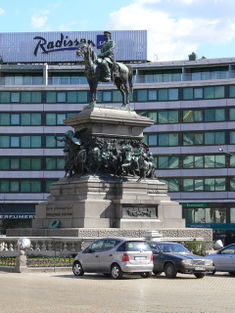 Monument to the Tsar Liberator |
 DSK Bank. |
 Statue of St Sofia. |
 Typical architecture of Sofia. |
Economy
Sofia is the major economic centre of Bulgaria and home to most major Bulgarian and international companies operating in Bulgaria. Sofia is also the country's financial hub, home to the Bulgarian National Bank, the Bulgarian Stock Exchange, the Financial Supervision Commission as well as the headquarters of all commercial banks operating in the country. Construction, trade and transport are other important sectors of the local economy. Increasingly, Sofia is becoming an outsourcing destination for multinational companies, among them IBM, Hewlett-Packard, SAP, Siemens, Software AG and Sony. Bulgaria Air, the national airline of Bulgaria, has its head office on the grounds of Sofia Airport.[20]
Up until 2007 Sofia experienced rapid economic growth. Apartment prices increased dramatically, with a growth rate of 30% in 2008.[21] In 2009, prices fell by 26%.[22]
Transport and infrastructure
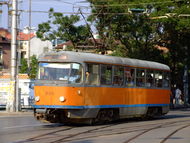
With its developing infrastructure and strategic location, Sofia is an important centre for international railway and automobile routes. Three Trans-European Transport Corridors cross the city: 4, 8 and 10. All major types of transport (except water transport) are represented in the city. It is home to eight railway stations,[23] the biggest of which is the Central Railway Station. Just next to it is the new Central Bus Station, the biggest and most modern of its kind in the country.[24] A number of other Bus Stations allow interurban and international trips from different parts of the city. The Sofia Airport with its new second terminal, finished in 2006, [25] handled some 2.7 million passengers in 2007. [26]
Public transport is well-developed with bus, tram (153,6 km network[23]) and trolleybus (97 km network[23]) lines running in all areas of the city.[27] [28] The Sofia underground became operational from 1998 and is yet largely underdeveloped with one line and only 14 stations.[29] Several new stations have been opened in 2009. Another, second line is being built with a targeted completion date in 2012. [29] The masterplan for the Sofia underground includes three lines with a total of 47 stations.[29] In recent years the marshrutka, a private passenger van, began serving fixed routes and proved an efficient and popular means of transport by being faster than public transport but cheaper than taxis. As of 2005 these vans numbered 368 and serviced 48 lines around the city and suburbs.[23] There are some 6,000 licensed taxi cabs operating in the city and another 2,000 operating somewhat illegally. [30] Low fares in comparison with other European countries, make taxis affordable and popular among a big part of the city population.
Private automobile ownership has grown rapidly in the 1990s; more than 1,000,000 cars were registered in Sofia in the last five years. The Sofia municipality is known for minor and cosmetic repairs and most streets are in a poor condition.[31] Consequently traffic and air pollution problems have become more severe and receive regular criticism in local media. The extension of the underground system is hoped to alleviate the city's immense traffic problems.
Sofia has a unique, very large combined heat and power (CHP) plant. Virtually the entire city (900,000 households and 5,900 companies) is centrally heated, using residual heat from electricity generation (3,000 MW) and gas- and oil-fired heating furnaces; total heat capacity is 4,640 MW. The heat distribution piping network is 900 km long and comprises 14,000 substations and 10,000 heated buildings.
Architecture
Historical landmarks
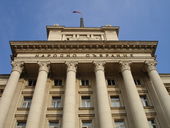
A number of ancient Roman, Byzantine and medieval Bulgarian buildings have been preserved in the city and its outskirts. Most notably, the 10th century Boyana Church (one of the UNESCO World Heritage protected sites), the Church of St. George, considered the oldest building in Sofia, and the early Byzantine Church of St Sophia.
A medieval monument of significant interest is the Church of St Petka of the Saddlers located in the very centre of the city providing a sharp contrast to the surrounding three Socialist Classicism edifices of the former Party House, TZUM, and Sheraton Sofia Hotel Balkan.
Post-liberation and Communism
After the Liberation of Bulgaria from Ottoman rule in 1878 and the establishment of an autonomous Bulgarian monarchy with its capital in Sofia, Knyaz Alexander Battenberg invited architects from Austria-Hungary to shape the new capital's architectural appearance.[32]
Among the architects invited to work in Bulgaria were Friedrich Grünanger, Adolf Václav Kolář, Viktor Rumpelmayer and others, who designed the most important public buildings needed by the newly-reestablished Bulgarian government, as well as numerous houses for the country's elite.[32] Later, many foreign-educated Bulgarian architects also contributed.
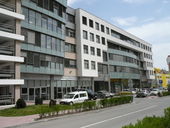
The architecture of Sofia's centre is thus a combination of Neo-Baroque, Neo-Rococo, Neo-Renaissance and Neoclassicism, with the Vienna Secession also later playing an important part, but it is mostly typically Central European.
Among the most important buildings constructed in Sofia in the period are the former royal palace, today housing the National Art Gallery and the National Ethnographic Museum (1882); the Ivan Vazov National Theatre (1907); the former royal printing office, today the National Gallery for Foreign Art; the National Assembly of Bulgaria (1886), the Bulgarian Academy of Sciences (1893), etc.
After the Second World War and the establishment of a Communist government in Bulgaria in 1944, the architectural line was substantially altered. Socialist Classicism public buildings emerged in the centre, but as the city grew outwards, the new neighbourhoods were dominated by many concrete tower blocks, prefabricated panel apartment buildings (panelki) and examples of Brutalist architecture.
After the abolishment of Communism in 1989, Sofia has witnessed the construction of whole business districts and neighbourhoods, as well as modern skryscraper-like glass-fronted office buildings, but also top-class residential neighbourhoods.
Education
There are 16 universities in Sofia. The Saint Clement of Ohrid University of Sofia is often regarded as the most prestigious university of Bulgaria, founded in 1888[33] The University enrolls 14,000 students annually. Other important universities include the National Academy of Arts, the Technical University of Sofia, the University for National and World Economics, Sofia Medical University, the Krastyo Sarafov National Academy for Theatre and Film Arts, the University of Architecture, Civil Engineering and Geodesy, the University of Forestry and New Bulgarian University.
Furthermore, institutions of national significance, such as the Bulgarian Academy of Sciences and the SS. Cyril and Methodius National Library are located in Sofia. The American College of Sofia, founded in 1860 and often regarded as the oldest American academic institution outside the United States,[34] provides secondary education to some of Bulgaria's brightest students.
The St. Clement of Ohrid University of Sofia is the oldest higher education institution in Bulgaria, founded on 1 October 1888. The university's edifice was constructed between 1924 and 1934 with the financial support of the brothers Evlogi Georgiev and Hristo Georgiev.[35]
Sports
Being the country's capital, Sofia is also the centre of Bulgaria's sporting activities, with a large number of sports clubs based in the city. These include most of Bulgaria's primary football teams, such as Levski, CSKA, Lokomotiv Sofia and Slavia, as well as formerly great clubs like Akademik, Spartak Sofia and Septemvri.[36] The capital's dominance in the sport is reflected in the fact that Sofia-based teams, including dissolved clubs like A.S. 23,[37] have been Bulgarian football champions on all but thirteen occasions since the national league was formed in 1923.
Although football is popular, sports such as basketball and volleyball have strong traditions. A notable basketball team in the capital is Lukoil Academic, who were twice European Champions Cup finalists.
While no major volleyball teams exist at club level (excluding multiple times champion and Volleyball Champions League participant Levski Sikonko), Bulgaria has always been among the world's top nations at the sport. The Bulgarian Volleyball Federation is the world's second-oldest, and it was an exhibition tournament organised by them in Sofia that in 1957 convinced the IOC to include volleyball as an olympic sport.[38]
Tennis is increasingly popular in Sofia. Currently there are some ten[39] tennis court complexes within the city including the one founded by former WTA top-ten athlete Magdalena Maleeva.[40] While rugby is a minor sport in Bulgaria, and certainly not a spectator sport, there are several rugby clubs in Sofia for aficionados of the game.
Most other sports, especially individual sports such as boxing, wrestling, and archery can be practiced at the sports complex of the NSA or at that of any of the sports clubs mentioned above. This is because, during the communist era, all sports clubs concentrated on all-round sporting development.
Sofia applied to host the Winter Olympic Games in 1992 and in 1994, coming 2nd and 3rd respectively. The city was also an applicant for the 2014 Winter Olympics, but was not selected as candidate. In addition, Sofia hosted Eurobasket 1957 and the 1961 and 1977 Summer Universiades, as well as the 1983 and 1989 winter editions.
Venues
The capital is home to a large number of sports venues, including the 43,000-seat Vasil Levski National Stadium which hosts most major outdoor events in Bulgaria, Levski Sofia's Georgi Asparuhov Stadium, CSKA Sofia's Balgarska Armiya Stadium, Slavia Sofia's Ovcha Kupel Stadium, and Lokomotiv Stadium stadium, which has hosted many major music concerts in recent years.
An important sports facility is the 3,000-capacity Universiade Hall, where in turn many indoor events are held, including Akademik's European basketball games. There are two ice skating complexes — the Winter Palace of Sports (capacity 4,000) and the Slavia Winter Stadium (capacity 2,000), both containing two rinks each.[41]
There is a velodrome with 5,000 seats in the city's central park. It is currently disused but undergoing renovation.[42]
Recreation
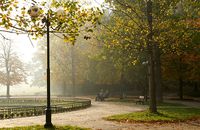
Most football stadiums have tennis courts, astroturf pitches and other sports facilities joined to them, and there are other such facilities scattered throughout the city, mainly in the parks.
There are also various other all-round sports complexes in the city which belong to institutions other than the football clubs, such as those of the National Sports Academy, of the Bulgarian Academy of Sciences, or those of the capital's various universities.
There are more than fifteen swimming complexes in the city, most of them outdoor.[43] Nearly all of these were constructed as competition venues and therefore have seating facilities for several hundred people.
There are two golf courses just to the east of Sofia — in Elin Pelin (St Sofia club) and in Ihtiman (Air Sofia club), and a horseriding club (St George club).
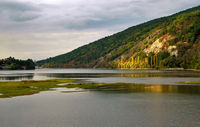
The capital's main attraction is probably the ample opportunity provided to Sofianites for making use of the city's sprawling parklands, many of which are densely forested. There are four such major parks - Tsar Boris's Garden in the city centre, as well as the Southern, Western and Northern and several other smaller parks, most notable of which are the City Garden and the Doctor Garden. The Vitosha Nature Park (the oldest national park in the Balkans [44]), which includes a big part of the Vitosha mountain to the south of Sofia, covers an area of almost 270 km² and lies entirely within the city limits.[45] Many Sofianites take weekly hikes up the mountain, and most do so at least a couple of times a year. There are bungalows as well as several ski slopes on Vitosha, allowing locals to take full advantage of the countryside and of the mountains without having to leave the city.
The Pancharevo lake area is a popular destination due to its scenery, historical heritage (Urvich fortress and Pancharevo monastery), as well as Bulgaria's largest rowing base - "Sredets".
Mass media
Some of the biggest and most popular telecommunications companies, TV and radio stations, cable television companies, newspapers, magazines, and web portals are based in Sofia. Some television companies and channels include Bulgarian National Television (featuring BNT Channel 1 and TV Bulgaria), bTV and Nova Television among others. Top-circulation newspapers include 24 chasa, Trud, Kapital and others.
Notable people
- See also: Category:People from Sofia
People that were born in Sofia:
- Elisaveta Bagryana (1893–1991), poetess
- Boris III (1894–1943), Tsar of Bulgaria
- Assen Jordanoff (1896–1967), Bulgarian-American aviation pioneer
- Cyril (1901–1971), Patriarch of Bulgaria
- Valeri Petrov (b. 1920), writer
- Stoyanka Mutafova (b. 1922), actress
- Itzhak Fintzi (b. 1933), actor
- Simeon II (b. 1937), former Tsar of Bulgaria and former Prime Minister of Bulgaria
- Georgi Asparuhov (1943–1971), football player
- Borislav Mikhailov (b. 1963), football player and Bulgarian Soccer Union president
- Evgenia Radanova (b. 1977), ice skater
- Antoaneta Stefanova (b. 1979), chess player and Women's World Chess Champion
- Viktor Antonov, Main Art designer of Valve worked on Half-Life 2 video-game series.
- Moni Moshonov (b. 1951), Israeli actor, comedian and theater director.
- Ivan Kostov (b. 1949), politician, ex-prime-minister (1997–2001)
- Yordanka Hristova, (b. 1943), singer
- Margarita Hranova (b. 1951), singer
- Vasil Naydenov (b. 1950), singer and composer
- Rositza Kirilova (b. 1963) singer
- Pasha Hristova (b. 1946), singer
- Antonia Neshev (b. 1962), creator of Three Wolf Moon T-Shirt
- Diliana Momtchilova, cellist
- Nina Dobrev, (b. 1989), actress
International relations
Twin towns — Sister cities
Sofia is twinned with:
 Algiers, Algeria
Algiers, Algeria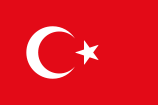 Ankara, Turkey (since 1992)
Ankara, Turkey (since 1992) Berlin, Germany
Berlin, Germany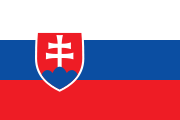 Bratislava, Slovakia (since 2008)
Bratislava, Slovakia (since 2008).svg.png) Brussels, Belgium
Brussels, Belgium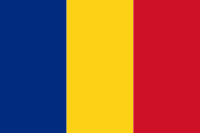 Bucharest, Romania
Bucharest, Romania Budapest, Hungary
Budapest, Hungary Bursa, Turkey (since 1998)
Bursa, Turkey (since 1998)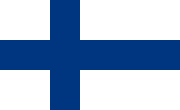 Helsinki, Finland
Helsinki, Finland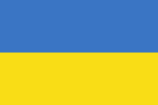 Kiev, Ukraine (since 1997)
Kiev, Ukraine (since 1997)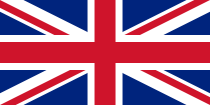 London, United Kingdom
London, United Kingdom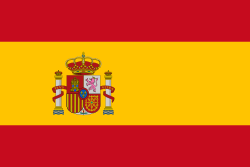 Madrid, Spain
Madrid, Spain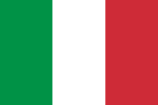 Milan, Italy
Milan, Italy Paris, France (since 1998)
Paris, France (since 1998) Pittsburgh, United States
Pittsburgh, United States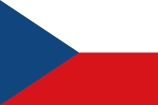 Prague, Czech Republic
Prague, Czech Republic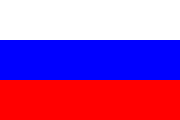 Saint Petersburg, Russia
Saint Petersburg, Russia Maraş, Turkey
Maraş, Turkey Skopje, Macedonia (since 2006)
Skopje, Macedonia (since 2006)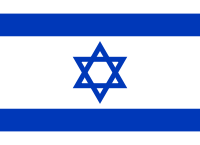 Tel Aviv, Israel (since 1992)
Tel Aviv, Israel (since 1992)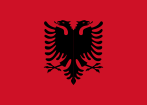 Tirana, Albania (since 2008)[46][47]
Tirana, Albania (since 2008)[46][47]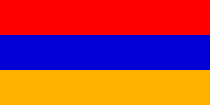 Yerevan, Armenia (since 2008)
Yerevan, Armenia (since 2008) Warsaw, Poland
Warsaw, Poland
Honour
Serdica Peak on Livingston Island in the South Shetland Islands, Antarctica is named after Serdica.
Images of old Sofia
 The former buildings of "Agricultural bank" and a national library in 1910. They were destroyed at the bombing in 1943-1944. |
 The former building of Bulgarian National Bank in 1910. |
 View of the Market Hall in 1912 |
 The rectorate of a Sofia University in 1935. |
 The building of Bulgarian Academy of Sciences in 1930. |
 The building of a chamber of commerce. |
 The house of Yablanski. |
 The Royal Printing Office in the early 20th century. |
 Hagia Sophia Church in 1915. |
 Monument to the Tsar Liberator in 1912. |
 St Nikola Sofiyski church in early 20th century. |
 The former "Targovska" street in 1914. |
 Ivan Vazov National Theatre in 1910. |
 The Banya Bashi mosque in 1900. |
 The Russian Church in 1916. |
 Ivan Vazov National Theatre in 1910. |
The Central Military Club. |
The Central Military Club. |
 Tsar Osvoboditel Boulevard in 1916. |
 The former central railway station. It was demolished in 1972. |
 St Nedelya Church in 1880. |
 St Nedelya Church in 1922, before the assault. |
 Church of St. George in late 19th century. |
 St Nedelya Church, after the assault in 1925. |
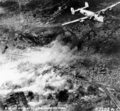 Bombings over Sofia in 1944. |
See also
- Sofia University
- Sofia Metro
- Sofia Airport
- Central Bus Station Sofia
- Streets in Sofia
- List of malls in Sofia
- List of tallest buildings in Sofia
- List of villages in Sofia City
- Sofia Province
- Plovdiv
- Varna
References
Notes
- ↑ "Sofia Trough Centuries". Sofia Municipality. http://www.sofia.bg/en/display.asp?ime=sofia. Retrieved 2009-10-16.
- ↑ "Таблица на населението по постоянен и настоящ адрес". ГД "Гражданска Регистрация и Административно Обслужване". http://grao.bg/tna/tab01.html. Retrieved 2008-03-10.
- ↑ "Population table by permanent and present address" (in Bulgarian). Head Direction of Residential Registration and Administrative Service. http://grao.bg/tna/tab01.html. Retrieved 2010-01-15.
- ↑ 4.0 4.1 The Cambridge Ancient History, Volume 3, Part 2: The Assyrian and Babylonian Empires and Other States of the Near East, from the Eighth to the Sixth Centuries BC by John Boardman, I. E. S. Edwards, E. Sollberger, and N. G. L. Hammond, ISBN 0-521-22717-8, 1992, page 600: "In the place of the vanished Treres and Tilataei we find the Serdi for whom there is no evidence before the first century bc.It has for long being supposed on convincing linguistic and archeological grounds that this tribe was of Celtic origin"
- ↑ Чолева-Димитрова, Анна М. (2002) (in Bulgarian). Селищни имена от Югозападна България: Изследване. Речник. София: Пенсофт. pp. 169–170. ISBN 9546421685. OCLC 57603720.
- ↑ 6.0 6.1 6.2 "BG Guide — Distances between cities in Bulgaria". bg.guide-bulgaria.com. http://bg.guide-bulgaria.com/bg_Distances.aspx. Retrieved 2008-05-25.
- ↑ World Map of the Köppen-Geiger climate classification updated. Meteorologische Zeitschrift, Vol. 15, No. 3, 259-263 (June 2006) © Gebrüder Borntraeger 2006. http://koeppen-geiger.vu-wien.ac.at/pdf/metz_15_3_0259_0263_kottek_wm.pdf. Retrieved 2010-01-22.
- ↑ (in Bulgarian) 120 ГОДИНИ ОТ НАЧАЛОТО НА РЕДОВНИТЕ МЕТЕОРОЛОГИЧНИ НАБЛЮДЕНИЯ В БЪЛГАРИЯ.. http://www.meteo.bg/docs/CMS_Sof_Hystory_Web.pdf. Retrieved 2010-01-22.
- ↑ "Hong Kong Observatory normals for - Sofia". http://www.weather.gov.hk/wxinfo/climat/world/eng/europe/gr_tu/sofia_e.htm.
- ↑ Theophanes Confessor. Chronographia, p.485
- ↑ s:Catholic Encyclopedia (1913)/Sardica
- ↑ Кираджиев, Светлин (2006). „София. 125 години столица. 1879-2004 година“. ИК „Гутенберг“. ISBN 978-954-617-011-8
- ↑ 13.0 13.1 "District Mayors". Sofia Municipality. http://sofia.bg/en/display.asp?ime=council. Retrieved 2009-12-26.
- ↑ София в числа, НСИ, 2003
- ↑ "Район "Подуяне"". Bsp-poduene.hit.bg. http://www.bsp-poduene.hit.bg. Retrieved 2009-05-06.
- ↑ "Basic demogaraphic indicators for Sofia" (in Bulgarian). National Statistic Institute website. http://www.nsi.bg/eventbg.php?n=443. Retrieved 2010-04-05.
- ↑ This statistic should not necessarily be taken at face value due to conflicting data – such as for the predominanly Roma neighbourhood of Fakulteta, which alone has a population of 45,000. [1]
- ↑ 2001 Census (Bulgarian) (English - less detailed) - recovered 26 June 2008. All other ethnic groups numbered less than one thousand; nearly 15,000 people said "other" or did not give an ethnicity.
- ↑ "Най-ниската безработица от 16 години насам е отчетена през юли". Aktualno.com. 2006-08-14. http://bulgaria.actualno.com/news_74069.html. Retrieved 2006-10-15.
- ↑ "Contacts." Bulgaria Air. Retrieved on 10 May 2010.
- ↑ "Bulgaria Housing Market Favors Buyers but Far Away from Collapse". www.novinite.com. http://www.novinite.com/view_news.php?id=101086. Retrieved 2009-02-08.
- ↑ "Bulgaria Residential Property Prices Down by 26% in Q4 y/y". www.novinite.com. http://www.novinite.com/view_news.php?id=112254. Retrieved 2010-01-30.
- ↑ 23.0 23.1 23.2 23.3 http://www.sofia.bg/pressecentre/images/OPR1part-4.pdf Sofia infrastructure from the official website of the Municipality (Bulgarian)
- ↑ "Central Bus Station — official website (Bulgarian)". www.centralnaavtogara.bg. http://www.centralnaavtogara.bg/cbs/home.nsf/0/1A207ED29E913C47C2256FE10035BDA3?OpenDocument. Retrieved 2008-05-24.
- ↑ "Sofia Airport — History". www.sofia-airport.bg. http://www.sofia-airport.bg/pages/content.aspx?tm01=109&tm02=78. Retrieved 2008-05-24.
- ↑ "Sofia Airport — News". www.sofia-airport.bg. http://www.sofia-airport.bg/pages/news.aspx?lm01=106&p=1. Retrieved 2008-05-24.
- ↑ "Public transport Sofia — official website (Bulgarian)". www.skgt-bg.com. http://www.skgt-bg.com/. Retrieved 2008-05-24.
- ↑ "Transport Company Bulgaria— official website (Bulgarian)". www.dak-transport.com. http://www.dak-transport.com/. Retrieved 2009-08-21.
- ↑ 29.0 29.1 29.2 "Metropolitan Sofia Web Place". www.metropolitan.bg. http://www.metropolitan.bg/index_bg.html. Retrieved 2008-05-24.
- ↑ "National Federation of the Taxi Drivers in Bulgaria. Regional Member Sofia". nftvb.com. http://nftvb.com/sofia.htm. Retrieved 2008-05-24.
- ↑ "Fines for bad repair work - 'Dnevnik' newspaper". www.dnevnik.bg. http://www.dnevnik.bg/show/?storyid=372682. Retrieved 2008-05-24.
- ↑ 32.0 32.1 Collective (1980). Encyclopedia of Figurative Arts in Bulgaria, volume 1. Sofia: Bulgarian Academy of Sciences. pp. 209–210.
- ↑ "Official website of the Sofia university — History". www.uni-sofia.bg. http://www.uni-sofia.bg/history-art/history/years.html. Retrieved 2008-05-31.
- ↑ This title is also claimed by Robert College, founded in 1863, due to the name and constitutional changes in the American College of Sofia's history.
- ↑ "American College of Sofia". www.acs.bg. http://www.acs.bg/en/acs_overview.php?case=3. Retrieved 2008-05-31.
- ↑ "See the article on the Bulgarian Wikipedia (Bulgarian)". bg.wikipedia.org. http://bg.wikipedia.org/wiki/%D0%A1%D0%B5%D0%BF%D1%82%D0%B5%D0%BC%D0%B2%D1%80%D0%B8_(%D0%A1%D0%BE%D1%84%D0%B8%D1%8F). Retrieved 2008-05-11.
- ↑ "Article about the club on the Bulgarian wikipedia (Bulgarian)". bg.wikipedia.org. http://bg.wikipedia.org/wiki/%D0%90%D0%A1-23. Retrieved 2008-05-11.
- ↑ "BVA-News". www.balkanvolleyball.org. http://www.balkanvolleyball.org/News.htm. Retrieved 2008-05-11.
- ↑ "Sofia municipality — Tennis courts". www.sofia.bg. http://www.sofia.bg/templkomp.asp?ime=TENISK%7D&title=%D1%F2%EE%EB%E8%F7%E5%ED%20%EA%EE%EC%EF%E0%F1&pathtitle=sport&opis=%D1%EF%EE%F0%F2. Retrieved 2008-05-11.
- ↑ "Тенис Клуб Малееви". www.maleevaclub.com. http://www.maleevaclub.com/. Retrieved 2008-05-11.
- ↑ "www.kunki.org: Skate rinks in Sofia". kunki.org. http://kunki.org/page.php?9. Retrieved 2008-05-11.
- ↑ "Journey.bg — History of the Sofia velodrome". journey.bg. http://journey.bg/bulgaria/bulgaria.php?guide=1916. Retrieved 2008-05-11.
- ↑ "Swimming pools in Sofia (including Spa centers)". tonus.tialoto.bg. http://tonus.tialoto.bg/article.php?id=2277. Retrieved 2008-05-11.
- ↑ "National parks in the world (Bulgarian)". journey.bg. http://journey.bg/bulgaria/bulgaria.php?>ype=21. Retrieved 2008-05-24.
- ↑ "Vitosha Mountain". www.vitoshamount.hit.bg. http://www.vitoshamount.hit.bg/. Retrieved 2008-05-11.
- ↑ "Twinning Cities: International Relations" (PDF). Municipality of Tirana. www.tirana.gov.al. http://www.tirana.gov.al/common/images/International%20Relations.pdf. Retrieved 2009-06-23.
- ↑ Twinning Cities: International Relations. Municipality of Tirana. www.tirana.gov.al. Retrieved on 2008-01-25.
Further reading
- "Sofia — 130 Years Capital" (in Bulgarian). http://www.alphabank.bg/130.
External links
- Three gigapiksels photo of Sofia from 08.10.2010
- City of Sofia
- Sofia public transport Official Site
- Sofia City Council (Bulgarian)
- Old pictures from Sofia* Sofia travel guide from Wikitravel
- Sofia, an external wiki
- Sofia at the Open Directory Project
- Virtual panoramas from Sofia
- Gallery of Sofia by Night
- Image Gallery from Sofia
- Video Photo Gallery of Sofia, Bulgaria (video)
- Archival images of Sofia
- Sofia live webcam - the Russian monument
- "Sofia"— pictures from Sofia
|
|||||
|
||||||||||||||||||||||||||||
|
||||||||||||||
|
|||||

